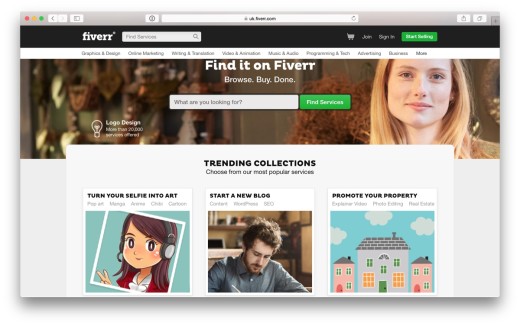
Back in the 2000s, if you came up with an idea and were sure it was unique, you were probably right. Not anymore. Today, with millions available from venture capitalists and e-entrepreneurs, startups are founded every day and competition is immense.
The question is, how do you survive in such an environment, differentiate your product and get your startup to grow? How do you find space in this crowded market? Unless you have something utterly innovative, you’ll need to get creative. Here are a few ways you can do that.
1. Go Local
This isn’t as much about creativity as good old-fashioned common sense. Going local is a low risk approach and it’s a model used to close successful US startups in other countries. Rocket Internet comes to mind. Back in 2011, its CityDeal was acquired by Groupon, which turned out to be an amazing deal for both companies.
It’s a proven system: you simply see what works in the US then tweak accordingly for the local market. Risk is comparatively low because you will most probably have a product-market fit and you can copy best practices from the leading US players. It’s all about how to grow and scale the business.

There’s two scenarios that might get you. The first is, the leading player might enter your local market in the future and capture your business. To be protected, your business has to have local network effects or high barriers to entry. For example, if your business is a local clone of Amazon selling consumer electronics, there’s the risk that Amazon decides to show up at your backyard and put you out of business.
If on the other hand you run a real-estate marketplace or a marketplace for babysitters, things are more difficult for new entrants because there’s the question of local supply and demand.
The second challenge is the local market may not have the critical mass for the type of business you’re planning. Imagine cloning DogVacay in a market with only five million people. It might be difficult to make it work.
2. Go Vertical
This is a tricky one. On the one hand offering generic services in a category lets you latch on to a large market and user base, but you also lose out on the opportunity to optimize the experience for vertical use cases. ‘Genericism’ is one of the most common ways businesses are losing market share.
Take for instance UpWork (previously oDesk). The platform offers most types of virtual work but they’re losing out on market share captured by niche vertical players. Some of these niche platforms are Scripted and Contently for content, 99designs for design work, UpCounsel for lawyers, Rev for audio transcriptions, and Gengo for translations.
Evidently, if there’s the opportunity to significantly optimize the experience by going vertical, that’s exactly what you should do. The only things to consider are the unit economics and the LTV of your users. Does your service have recurring use? Is the ticket-value high enough to pay off for your marketing?

A freelancing platform that specializes in writers who only write “Terms and Conditions” simply wouldn’t work because most clients would need that service only once. On the other hand, a copywriting marketplace would be sustainable because there would be a large enough volume of work and also recurring need from clients.
3. Focus on Quality
The bigger you get the harder it is to control quality. It’s a simple fact but one that can be leveraged by startups. Large, unmonitored freelance platforms, just like leading ecommerce outlets find it extremely difficult to maintain quality levels because it’s just not cost-effective for them. For the new entrant, this is an opportunity.
There are two ways to go about this. The first is to build a high-quality, curated supply. If you run an e-shop, stock only high-quality products. If you are a marketplace, let in only the best sellers in. Think of Toptal. It’s a marketplace where you only find elite engineers – the top three percent in their fields.
This clearly differentiates Toptal from Upwork, a marketplace that lets anyone in. The second way to leverage the opportunity is to provide a managed service. OneFineStay offers a similar service as Airbnb but it also manages hosts’ properties, operating them like hotels.
4. Offer a Disruptive Experience
It’s hard to be different when so many others have the same idea. Yet, done right, offering a unique experience can totally transform a startup and pave the way for its future. What makes ‘good disruption’ so hard to achieve is that you have to build something that is at least 10x better than what already exists, an experience utterly unique, marketable and effective at the same time.
Just improving an existing service won’t cut it. Your way should be so much better that it makes a tangible difference in the user’s life. You’ll want users to change their habits and go out of their comfort zone to use your service.

When Fiverr launched as the first-of-its-kind ‘micro-gig’ marketplace, it was the fastest growing company in the freelance space. 99designs was the first to offer contests as a way to get creative work, and it was massively successful as well.
The business sphere is chockfull of successful disruption stories: Slack disrupted the collaboration tools space. Google disrupted the search space by offering a much better algorithm. The takeaway is simple. You simply provide a better version of something that’s already out there, and you do it in a way no one else is.
The problem is that until you launch it, you don’t know whether your idea will be a disruptive one. Initially, most things are subjective and gutt-feeling based. But you have to be brutally honest with yourself, objective and try to answer questions like: Do I offer something so compelling that users not only will love it but it will also validate the switching costs out of what they already use? Does my idea change the status quo? This 4th option is the most difficult one but also the most-rewarding. If you get it right, then sky is the limit.
But even if you don’t manage to crack it initially, you should not surrender and try to target different audiences until you find the right market or product. Take for instance Paypal. It originated as a way to exchange money via PDAs (handheld digital computers, such as the Palm Pilot, an early incarnation of the smartphone), back in 1999.

Peter Thiel saw the potential to solve a much larger problem – an easy way to transfer money online and PayPal became the preferred online payment system for eBay sellers, which propelled its name into payment processing fame. Another example is Flickr, it was originally a multi-player on-line game called Neverending which included a photo sharing functionality. Founders recognized that the photo sharing aspect could be retargeted to a broader market and abandoned the game.
Choosing your path can be tricky and often depends on your aspirations and intuition, opportunities within the market you are targeting and how much risk you want to take. In the end it’s not just about coming up with a great idea and jumping into it head-first. A little homework and careful strategizing can go a long way in shaping the future of a fledgling startup.
Read Next: YouTube reportedly launching new subscription service next month
Image credit: Shutterstock
Get the TNW newsletter
Get the most important tech news in your inbox each week.





